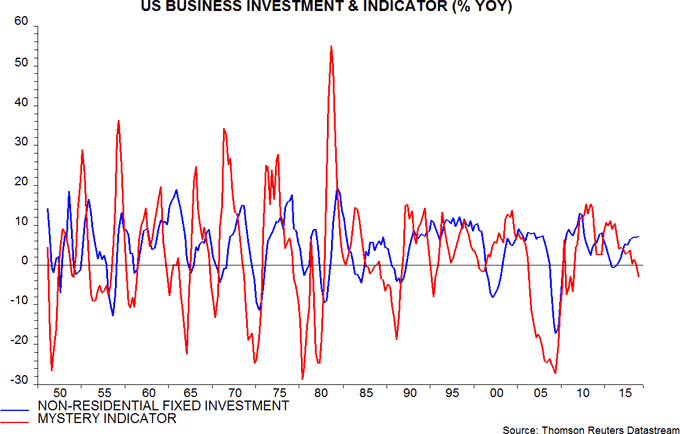Entries from March 10, 2019 - March 16, 2019
Chinese money update: no reflation signal
Chinese money and credit trends remain weak, casting doubt on claims that policy stimulus is gaining traction and will lead to a significant recovery in economic momentum later in 2019.
Economic data for January / February signal a further decline in year-on-year nominal GDP growth in the first quarter– see first chart. Additional weakness had been expected given a continued softening of narrow money and credit trends through 2018.
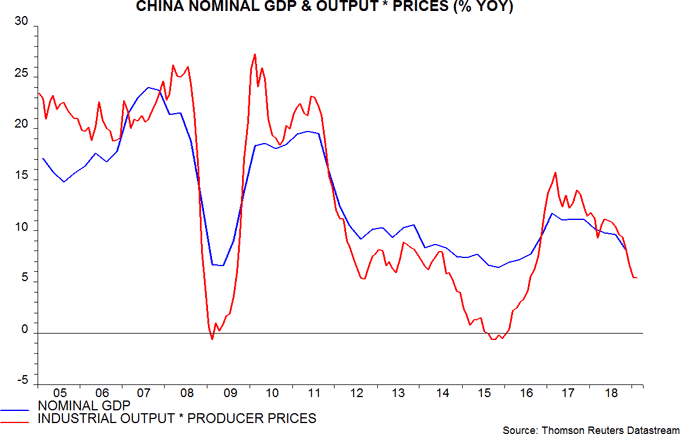
A strong monthly flow of broad credit – “total social financing” (TSF) – in January was trumpeted by optimists as signalling a turning point. Such an interpretation was hazardous given the volatility of the monthly data and a likely positive New Year timing effect. The February number, unsurprisingly, slumped.
The optimists argue that the combined January / February flow was still 25% higher than a year before but this creates a misleading impression. Expressed as a percentage of the stock, the January / February increase was 2.5%, which – although up from 2.2% last year – was lower than January / February growth in each year from 2013 through 2017.
Year-on-year TSF growth fell back from 10.4% in January to 10.1% in February, barely higher than December’s 9.8% record low – second chart.
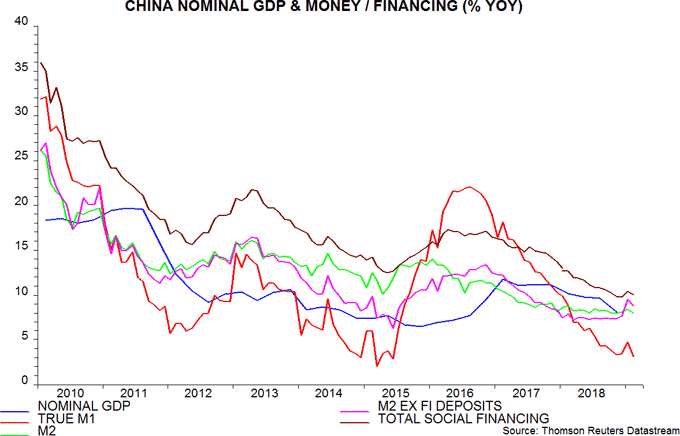
The forecasting approach here focuses on narrow money rather than credit but recent trends are equally discouraging. After a small rally in December / January, year-on-year growth of true M1 – which adds household demand deposits to the official M1 measure – declined to a new 44-month low in February.
Broad money trends are somewhat difficult to interpret. Year-on-year M2 growth fell back to its recent low of 8.0% in February. A contraction of bank deposits of non-bank financial institutions, however, has exerted a major drag on the aggregate in recent months, i.e. M2 growth excluding such deposits has picked up. The judgement here is that these trends reflect the clampdown on shadow banking and a consequent shift of business onto banks’ balance sheets. The rise in M2 growth of households and non-financial enterprises / government organisations may have been offset by a reduction (unrecorded) in holdings of shadow system liabilities, such as wealth management products. The shadow system contraction may also explain the fall in deposits of non-bank financial institutions. If this interpretation is correct, aggregate M2 may currently be the better measure to use for assessing economic prospects.
Shorter-term trends in the money / credit aggregates give a similarly downbeat message to year-on-year growth rates. Six-month growth of true M1 remains range-bound at a low level, while that of TSF has slipped back – third chart.
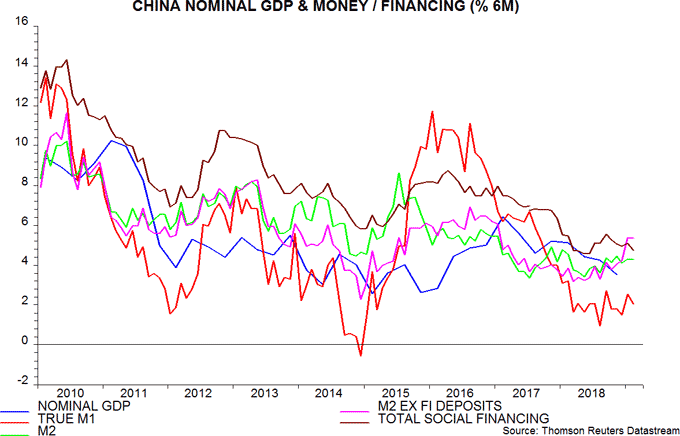
Six-month real growth rates have been boosted by a recent energy-driven fall in consumer price inflation but this is likely to unwind into mid-year.
OECD leading indicators still weakening
The OECD’s composite leading indicators support the expectation here of a further loss of global economic momentum into mid-2019.
The OECD’s indicators provide an independent, though less timely, cross-check of signals from monetary trends. With rare exceptions (e.g. Canada, India), the country indicators do not contain a monetary component. They tend to be dominated by business and consumer survey information, though also include financial indicators such as equity prices and the yield curve.
As previewed in a post last week, the G7 composite indicator registered another significant monthly fall in January, suggesting that GDP expansion will remain well below trend over coming months – see first chart.
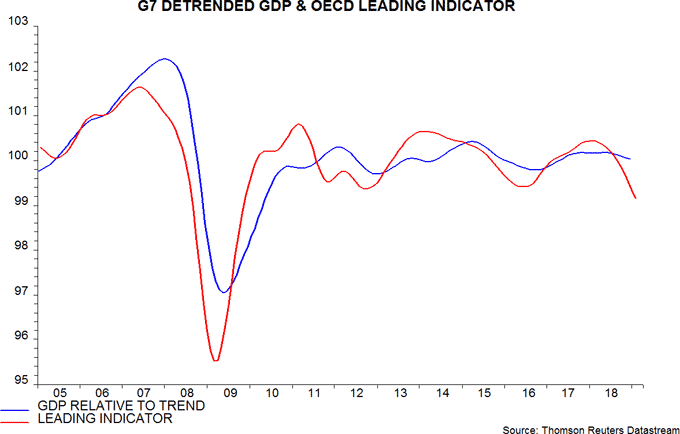
The OECD’s practice of presenting its indicators in trend-adjusted form obscures important information about their internal momentum. An alternative approach followed here involves:
- Combining country indicators for the G7 and emerging E7 to create a “global” trend-adjusted measure.
- Combining this measure with an estimate of the trend in G7 plus E7 industrial output to form an indicator of the level of output.
- Using turning points in the rate of change of this indicator to anticipate turning points in industrial output momentum.
Historically, turning points in the six-month change in the indicator have led turning points in six-month output momentum by four to five months on average – second chart.
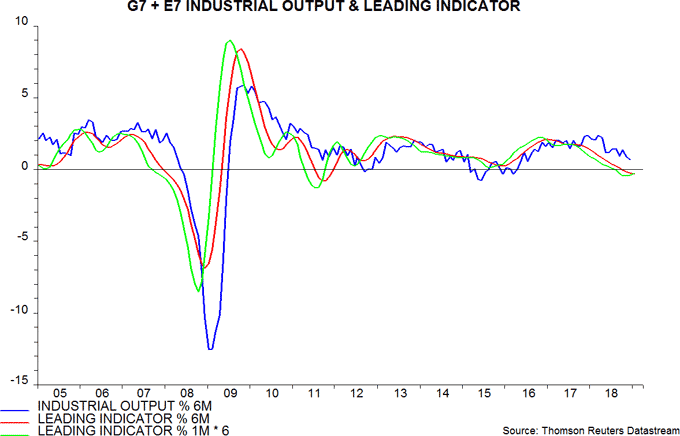
The central view here, based on monetary trends, is that global six-month industrial output momentum will bottom around July 2019. Such a scenario would suggest a low in the six-month change of the leading indicator in February or March.
Consistent with this scenario, the six-month indicator change continued to weaken in January. The one-month change, however, recovered marginally – this could be a precursor to the six-month change bottoming over the next several months.
The suggestion that economic momentum will reach a low around July does not imply an optimistic assessment of prospects for later in 2019. Developments judged here to be necessary to warrant such an assessment include:
- A further pick-up in G7 plus E7 six-month real narrow money growth to 3-4% (not annualised) from January’s level of 1.9%.
- Confirmation of a bottoming out of the six-month leading indicator change by April (data to be released in early June).
- Sufficient weakness in stockbuilding and business investment data in the first half of 2019 to suggest completion of cycle downswings during the second half.
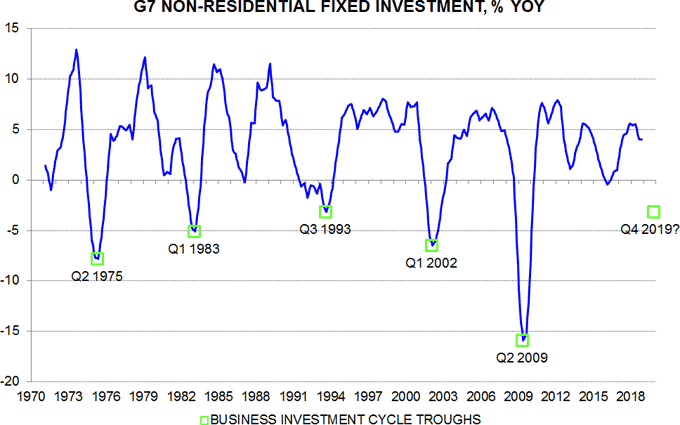
On the latter point, a correspondent asked whether solid investment data for the US and Euroland in the fourth quarter of 2018 altered the assessment here about the timing and magnitude of a cycle downswing. The answer is no. Year-on-year growth of G7 non-residential fixed investment was unchanged in the fourth quarter and below a peak reached in the second quarter – third chart. Investment is closely correlated with industrial output of capital goods, which fell significantly year-on-year in Japan, Euroland and the UK in December / January – fourth chart. The relationship shown in the fifth chart, meanwhile, suggests that US investment resilience will crumble – the identity of the mystery indicator may surprise readers.

